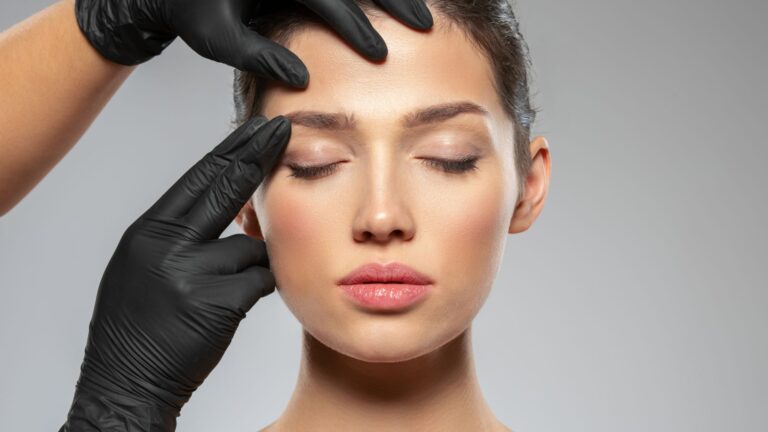Over Exfoliated Skin: Signs, How to Fix It & Prevention
One of my favorite things to warn people about is over-exfoliation, and for good reason. Your face is red, tight, and stings when water touches it. You’re staring in the mirror wondering if you’ve permanently damaged your skin. You haven’t, but you need to understand what’s happening.
This happens to about 70% of people who use exfoliants. The damage isn’t permanent, and your skin will recover with the right approach.
Emergency Protocol – Do This Today If You Have Over Exfoliated Skin: Stop all exfoliants immediately. Apply cool compress for 10 minutes, 3x daily. Use only gentle cleanser and bland moisturizer. Full recovery guide below.

This post contains affiliate links. As an Amazon Associate, I earn from qualifying purchases. Read full disclosure
What Is Over Exfoliation?
Over-exfoliation is the excessive removal of dead skin cells through physical or chemical means, damaging the skin’s protective barrier faster than it can repair itself. Signs include stinging, redness, increased breakouts, and sensitivity to products that normally work fine.
Your skin naturally sheds dead cells every 28 days through desquamation, which is just the technical term for your skin’s built-in renewal system. For most people, this happens efficiently without much help. The skincare industry wants you to believe otherwise.
Walk down any skincare aisle and you’ll see exfoliating peels, toners, creams, scrubs. The marketing pushes constant buffing, sanding, and polishing. Most people don’t actually need that level of intervention.
Your skin barrier works like a brick wall. The cells are the bricks, held together by mortar made of lipids (fats) and proteins. This barrier keeps irritants out and moisture locked in. When you over-exfoliate, you’re breaking down both the bricks and mortar faster than your skin can rebuild them. The result is gaps that let irritants penetrate while water escapes.
Many people don’t realize they’re over-exfoliating because individual products seem gentle. A glycolic acid toner in the morning, salicylic acid cleanser at night, retinol before bed. Suddenly you’re using three exfoliants daily without meaning to. The industry does little to educate you about this. They just keep pumping out products.
Types of Exfoliants: Physical, Chemical & Hidden

This is where it gets tricky. Many people don’t realize how much they’re actually exfoliating because it’s hiding in products you wouldn’t expect.
Physical exfoliants have abrasive particles – coffee, sugar, walnut shells. Brushes, buff puffs, even washcloths. These physically sand your skin and can create micro-tears in your barrier, causing dryness and irritation.
Chemical exfoliants include alpha hydroxy acids or AHAs (glycolic, lactic, mandelic acid), beta hydroxy acids or BHAs (salicylic acid), and even urea at certain concentrations. These dissolve the connections between skin cells so they shed more easily. They’re more precise than physical scrubs but just as easy to overdo.
Retinoids increase cell turnover, so tretinoin, adapalene, retinol, and retinaldehyde all count as exfoliation. If you use retinol at night, you’re already exfoliating.
Hidden exfoliants show up everywhere. Your cleanser might have salicylic or glycolic acid. Your toner probably has AHAs or BHAs. That “brightening” serum likely contains acids. Some vitamin C formulations exfoliate. Even your moisturizer might have low-level acids. It’s worth checking every single product.
The most important rule: use only one exfoliating product per routine. If you use retinol three nights weekly, you can only add acid exfoliation once weekly on off nights. That’s it.
8 Signs You’ve Over Exfoliated Your Skin
When you exfoliate, you’re targeting the stratum corneum, your protective barrier layer. As you age or if you have dry skin, this layer can build up and make your skin look dull. Exfoliants remove that buildup, which is helpful. The problem is knowing when to stop.
This layer isn’t the same thickness everywhere on your body. It’s thick on your palms and soles, thin around your eyelids, and your lips don’t have one at all. Some thinning is good for your skin, but too much leaves it vulnerable to water loss, dryness, irritation, worsened hyperpigmentation, and acne flares.
1. Your Products Suddenly Burn and Sting
Your moisturizer and sunscreen now feel uncomfortable. You get stinging, maybe redness when you apply them. That protective layer has been stripped down and can’t shield you from ingredients getting into deeper layers of your skin. You’re having heightened responses to otherwise harmless products like basic moisturizer.
2. You’re Breaking Out More
This is the most common and frustrating sign. You’re losing more water from your skin, which causes dryness and weakens your skin’s protective barrier. That leads to irritation, which triggers acne. You get more breakouts and think “I need to exfoliate more” or “I need a stronger product.” It’s a losing cycle. The exfoliating is causing the problem, not solving it.
3. Your Hyperpigmentation Is Getting Worse
This especially affects people with deeper skin tones. You might be using glycolic acid to fade post-acne marks, going too frequently or too strong, causing irritation. Any hint of irritation can worsen hyperpigmentation in deeper skin tones. If you have a deeper skin tone, you don’t need to avoid exfoliants entirely, but it’s important to proceed more cautiously than someone whose skin doesn’t heal with discoloration.
4. Your Fine Lines Look More Obvious
When you overdo exfoliating, your barrier struggles to hold water the way it should. Dermatologists have a fancy term for this – transepidermal water loss – but all it means is your skin can’t hold onto water and stay plumped up. You’ll likely notice wrinkles and fine lines becoming more obvious because there’s less water filling out your skin. The frustrating part is that many people use exfoliants specifically to improve these aging signs. When they see the lines getting worse, they don’t connect it to the exfoliant and end up buying an even stronger product, making the cycle worse.
5. You’re Red All the Time
When your barrier loses water, your skin becomes more likely to develop redness. This often comes with those burning and stinging sensations, but you might just notice your face gets red more easily than before.
6. Cold Weather Feels Brutal
If you’re over-exfoliating and live in a cold, dry climate, you’ll really feel it. You have less barrier protection from the elements. The low humidity pulls more water from your already vulnerable skin. Cold wind can feel like it’s attacking your face because your skin struggles to protect itself properly.
7. You’ve Lost That Healthy Glow
As your skin loses water, it loses that radiant look you were seeking when you started using these products. Your skin looks dull and feels rough despite all the “brightening” products you’re using.
8. The Sun Suddenly Bothers You
Alpha hydroxy acids like glycolic acid make your skin more sensitive to UV rays. The bitter irony: that increased sensitivity makes you more vulnerable to sun damage, which causes the visible aging signs you’re trying to improve with exfoliants. UV exposure also drives hyperpigmentation. So if you heal with discoloration, you now have both more irritation driving pigmentation and greater vulnerability to UV rays. Those rays come through window glass, by the way.
Quick Check: Are You Over-Exfoliated?
Stinging with regular products + Increased breakouts + Persistent redness = Stop all exfoliation now
Now that you know what you’re dealing with, let’s fix it.
How to Fix Over Exfoliated Skin
Week 1: Emergency Mode
Stop all exfoliation. Everything. This includes obvious exfoliants and hidden ones. Read every ingredient list. That moisturizer might have lactic acid. That cleanser probably has salicylic acid. Even weak exfoliants need to be avoided right now.
Skip these ingredients completely:
- Salicylic acid, lactic acid, glycolic acid, mandelic acid
- Urea (it’s moisturizing but exfoliates at certain percentages)
- Retinol and tretinoin
- Benzoyl peroxide
- Any product that tingles, warms, or causes any sensation
Your new minimal routine:
Morning:
- Lukewarm water rinse or gentle cleanser (Cetaphil Gentle Cleanser or Avene Extremely Gentle Cleansing Lotion)
- Bland moisturizer (Vanicream works well)
- Physical sunscreen with zinc oxide or titanium dioxide
Evening:
- Gentle cleanser
- Bland moisturizer (use a double layer if your skin feels tight)
Use cool or lukewarm water, never hot. Hot water breaks down your barrier even more.
Apply cool compresses for 10 minutes, three times daily. The cold constricts blood vessels and reduces inflammation, giving your skin a chance to calm down.
Look for glycerin and ceramides in your moisturizer. Both support barrier recovery. It’s best to avoid anything with urea, which can sting and may keep exfoliating your damaged skin.
Consider running a humidifier in your bedroom at night. As you sleep, your skin loses more water because it’s busy repairing damaged collagen and going through its natural recovery processes. The humidifier can help cut down on that moisture loss.
Week 2-4: Watching Recovery Happen
You should see reduced redness and less stinging by day 10 to 14. If your symptoms worsen or don’t improve at all after two weeks of proper care, see a dermatologist. Something else might be going on.
That top layer that got thinned out – the stratum corneum – turns over in about 2 to 4 weeks. Your entire epidermis turns over in approximately 30 days. Most people see noticeable improvement within 10 to 14 days of stopping the damage and supporting their barrier properly.

What to expect:
Mild over-exfoliation: You’ll recover in 3-7 days
Moderate over-exfoliation: Recovery takes 1-3 weeks, with noticeable improvement by week 2
Severe over-exfoliation: You’re looking at 4-8 weeks, and you should see a dermatologist if there’s no improvement after 2 weeks
When You Can Start Exfoliating Again
Wait at least one full week after your skin feels completely normal. You’ll know you’re ready when:
- Products don’t sting anymore
- Your redness is completely gone
- Your texture feels back to normal
- Your skincare products absorb at their usual rate
Start with the gentlest option available. Mandelic acid has the largest molecular size, which means it penetrates slowly and causes less irritation. Lactic acid has hydrating properties that buffer the exfoliation. Enzyme exfoliants like papain or bromelain work more gently than acids.
Begin once weekly at the lowest concentration you can find. Wait two full weeks before you even think about increasing frequency. Your tolerance has changed. What worked before might be too aggressive now, and that’s completely fine. Gentler doesn’t mean less effective.
Preventing Over Exfoliation
Know Your Frequency Limits
Dry or sensitive skin: 1-2 times per week maximum
Normal skin: 2-3 times per week
Oily or resilient skin: 3-4 times per week, never daily
These are maximums, not goals to hit. Your skin might need less than these numbers. More exfoliation doesn’t equal better results.
Listen to What Your Skin Is Telling You
Your skin will tell you if your routine is working or if you need to adjust.
Keep going if you notice:
- Smooth texture without tightness
- Even tone
- Products absorbing within 5-10 minutes
- No unusual sensitivity
Pull back if you notice:
- Mild tightness lasting more than 30 minutes after exfoliating
- Slight sensitivity to one or two products
- Minor flaking in your T-zone
Stop everything if you notice:
- Any stinging or burning with products
- Redness lasting more than 2 hours
- Sudden sensitivity to products you used to tolerate
- Increased breakouts
Remember, most people don’t need to exfoliate as much as they think. Simply washing your face with your fingers helps dislodge dead skin cells. Using moisturizer improves moisture content in your stratum corneum, which allows your natural exfoliation process to work more efficiently.
Bottom Line
This is honestly one of the hardest territories for consumers to navigate. You know exfoliating can be beneficial, but nobody explains how easy it is to overdo it. The skincare marketing comes with little instruction and zero transparency about acid strength. You can’t figure out how strong something really is from an ingredient list alone.
Certain skin types face more risk from over-exfoliating, especially deeper skin tones that can develop post-inflammatory hyperpigmentation from the irritation.
You could honestly keep this boring routine going forward: gentle cleanser once daily, bland moisturizer morning and night, sunscreen during the day. There’s nothing wrong with that approach. Your skin exfoliates on its own. Even as you age and that natural process slows down, it still happens. The simple act of washing your face helps. Keeping your skin moisturized allows the natural turnover to work efficiently.
The goal isn’t perfect skin immediately. It’s healthy skin that can tolerate beneficial treatments long-term without breaking down. Sometimes exfoliating less frequently produces better results than aggressive daily routines. Your skin rewards patient, informed care with genuine, lasting improvements.








